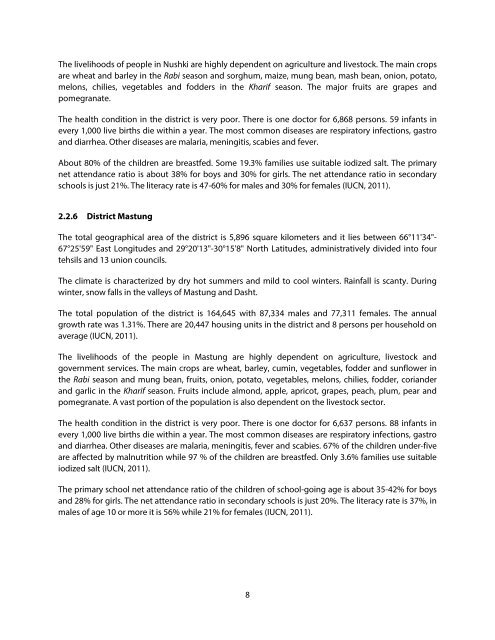Province of Balochistan Pakistan
Drought-Risk-Asst-Balochistan-Nov 2015-lowres
Drought-Risk-Asst-Balochistan-Nov 2015-lowres
You also want an ePaper? Increase the reach of your titles
YUMPU automatically turns print PDFs into web optimized ePapers that Google loves.
The livelihoods <strong>of</strong> people in Nushki are highly dependent on agriculture and livestock. The main crops<br />
are wheat and barley in the Rabi season and sorghum, maize, mung bean, mash bean, onion, potato,<br />
melons, chilies, vegetables and fodders in the Kharif season. The major fruits are grapes and<br />
pomegranate.<br />
The health condition in the district is very poor. There is one doctor for 6,868 persons. 59 infants in<br />
every 1,000 live births die within a year. The most common diseases are respiratory infections, gastro<br />
and diarrhea. Other diseases are malaria, meningitis, scabies and fever.<br />
About 80% <strong>of</strong> the children are breastfed. Some 19.3% families use suitable iodized salt. The primary<br />
net attendance ratio is about 38% for boys and 30% for girls. The net attendance ratio in secondary<br />
schools is just 21%. The literacy rate is 47-60% for males and 30% for females (IUCN, 2011).<br />
2.2.6 District Mastung<br />
The total geographical area <strong>of</strong> the district is 5,896 square kilometers and it lies between 66°11'34"-<br />
67°25'59" East Longitudes and 29°20'13"-30°15'8" North Latitudes, administratively divided into four<br />
tehsils and 13 union councils.<br />
The climate is characterized by dry hot summers and mild to cool winters. Rainfall is scanty. During<br />
winter, snow falls in the valleys <strong>of</strong> Mastung and Dasht.<br />
The total population <strong>of</strong> the district is 164,645 with 87,334 males and 77,311 females. The annual<br />
growth rate was 1.31%. There are 20,447 housing units in the district and 8 persons per household on<br />
average (IUCN, 2011).<br />
The livelihoods <strong>of</strong> the people in Mastung are highly dependent on agriculture, livestock and<br />
government services. The main crops are wheat, barley, cumin, vegetables, fodder and sunflower in<br />
the Rabi season and mung bean, fruits, onion, potato, vegetables, melons, chilies, fodder, coriander<br />
and garlic in the Kharif season. Fruits include almond, apple, apricot, grapes, peach, plum, pear and<br />
pomegranate. A vast portion <strong>of</strong> the population is also dependent on the livestock sector.<br />
The health condition in the district is very poor. There is one doctor for 6,637 persons. 88 infants in<br />
every 1,000 live births die within a year. The most common diseases are respiratory infections, gastro<br />
and diarrhea. Other diseases are malaria, meningitis, fever and scabies. 67% <strong>of</strong> the children under-five<br />
are affected by malnutrition while 97 % <strong>of</strong> the children are breastfed. Only 3.6% families use suitable<br />
iodized salt (IUCN, 2011).<br />
The primary school net attendance ratio <strong>of</strong> the children <strong>of</strong> school-going age is about 35-42% for boys<br />
and 28% for girls. The net attendance ratio in secondary schools is just 20%. The literacy rate is 37%, in<br />
males <strong>of</strong> age 10 or more it is 56% while 21% for females (IUCN, 2011).<br />
8


